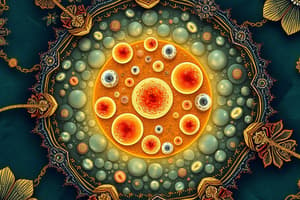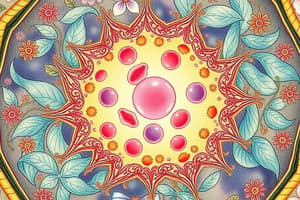Podcast
Questions and Answers
What is the primary function of the plasma membrane in eukaryotic cells?
What is the primary function of the plasma membrane in eukaryotic cells?
- Protein synthesis.
- Facilitating exchanges of materials and information. (correct)
- Photosynthesis in plant cells.
- Energy production through cellular respiration.
Which of the following is a primary function of vacuoles in plant cells?
Which of the following is a primary function of vacuoles in plant cells?
- Photosynthesis.
- Protein synthesis and modification.
- Energy production.
- Storage of substances and maintaining turgor pressure. (correct)
Which organelle is responsible for protein synthesis in all cells?
Which organelle is responsible for protein synthesis in all cells?
- Golgi apparatus.
- Chloroplasts.
- Endoplasmic reticulum.
- Ribosomes. (correct)
What distinguishes mitochondria from chloroplasts?
What distinguishes mitochondria from chloroplasts?
Which organelles are involved in the modification and sorting of proteins and lipids?
Which organelles are involved in the modification and sorting of proteins and lipids?
What type of cells contain chloroplasts?
What type of cells contain chloroplasts?
Which of the following correctly describes the endoplasmic reticulum?
Which of the following correctly describes the endoplasmic reticulum?
What is the main component of the cell wall in plant cells?
What is the main component of the cell wall in plant cells?
Flashcards are hidden until you start studying
Study Notes
External Structures
- Plasma Membrane (Cytoplasmic Membrane): Thin layer surrounding all cells, made of lipids and proteins. It controls what enters and leaves the cell, providing protection.
- Cell Wall: Found in plant cells and some bacteria, this rigid layer surrounds the cell membrane, giving structure, protection, and maintaining cell shape.
Cytoplasm
- Cytosol (Cytoplasm): The liquid inside cells, it holds organelles in place and supports metabolic reactions.
The Nucleus
- The Nucleus: Contains the cell's genetic material, DNA, and controls cellular activities.
Other Organelles
- Vacuoles: Membrane-bound sacs, often larger in plant cells. They store substances, dispose of waste, and maintain turgor pressure.
- Mitochondria: Double-membrane structures with inner folds. They are responsible for cellular respiration, the process of energy production.
- Chloroplasts: Found in plant cells, they are double-membrane structures with internal membranes called thylakoids. They are the site of photosynthesis.
- Golgi Apparatus: Composed of stacked flattened sacs and vesicles. It modifies, sorts, and packages proteins and lipids.
- Ribosomes: Made of proteins and rRNA, these are involved in protein synthesis.
- Endoplasmic Reticulum (ER): A network of membranes extending throughout the cell. There are two types: rough ER (with ribosomes) and smooth ER. The ER is involved in protein synthesis, modification, and transportation.
Studying That Suits You
Use AI to generate personalized quizzes and flashcards to suit your learning preferences.




